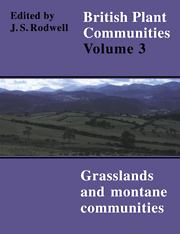Book contents
- Frontmatter
- Contents
- List of Figures
- Preface and Acknowledgements
- Preamble
- Mesotrophic Grasslands
- Community Descriptions
- Calcicolous Grasslands
- Community Descriptions
- Calcifugous Grasslands and Montane Communities
- Community Descriptions
- Index of Synonyms to Grasslands and Montane Communities
- Index of Species in Grasslands and Montane Communities
- Bibliography
U8 - Carex Bigelowii-Poly Trichum Alpinum Sedge-Heath
Published online by Cambridge University Press: 04 July 2020
- Frontmatter
- Contents
- List of Figures
- Preface and Acknowledgements
- Preamble
- Mesotrophic Grasslands
- Community Descriptions
- Calcicolous Grasslands
- Community Descriptions
- Calcifugous Grasslands and Montane Communities
- Community Descriptions
- Index of Synonyms to Grasslands and Montane Communities
- Index of Species in Grasslands and Montane Communities
- Bibliography
Summary
Synonymy
Dicranum fuscescens-Carex bigelowii sociation Poore 1955c; Dicraneto-Caricetum bigelowii McVean & Ratcliffe 1962; Polytricheto-Caricetum bigelowii McVean & Ratcliffe 1962 p.p.
Constant species
Carex bigelowii, Dicranum fuscescens, Polytrichum alpinum, Cetraria islandica, Cladonia arbuscula, C. bellidiflora.
Rare species
Cetraria delisei.
Physiognomy
The Carex bigelowii-Poly trichum alpinum sedge-heath comprises short swards, generally closed but often with a rather patchy structure, in which Carex bigelowii, Poly trichum alpinum axwfQx Dicranum fuscescens are typically the most abundant plants. Quite often, the sedge is strongly dominant, growing with some vigour where there is obvious irrigation in melt-water channels, but in other cases it is reduced to scattered clumps and rivalled or exceeded in cover by dull green carpets of the mosses. Other common species are few in number, but characteristically there is frequent but rather sparse representation of a number of lichens, Cetraria islandica, Cladonia arbuscula, C. bellidiflora, C. uncialis and C. pyxidata being found most often, C. gracilis, C. coccifera, C. rangiferina, C. squamosa and C.floerkeana more occasionally.
In contrast to the Nardus-Carex grass-heath, with which this vegetation is often found, Nardus stricta is only very occasional here and always of low cover, though Deschampsia flexuosa and Festuca ovinalvivipara occur fairly frequently and each can show modest abundance. There can also be some Agrostis capillaris and D. cespitosa, including obvious ssp. alpina, but the community only exceptionally has an overall grassy appearance. Woody plants are also of limited occurrence: one kind of Carex-Poly trichum sedge-heath has quite common records for Vaccinium myrtillus but it is never really abundant and, though Salix herbacea can have locally high cover, it is in general a scarce plant on the fairly stable ground characterised by this vegetation. Among other herbaceous associates, only Huperzia selago and Galium saxatile occur with anything more than very occasional frequency, with Luzula spicata, Juncus trifidus and Saxifraga stellaris recorded rarely.
Apart from the two constant mosses, no other bryophytes are found frequently throughout, but Ptilidium ciliare occurs commonly in one kind of Carex-Polytrichum vegetation, and Racomitrium lanuginosum in the other and, less frequently, there is some Dicranum scoparium, Pohlia nutans, Racomitrium fasciculare and Pleurozium schreberi. In contrast to the more chionophilous kinds of Deschampsia-Galium vegetation, bulky hypnaceous mosses are never abundant.
- Type
- Chapter
- Information
- British Plant Communities , pp. 389 - 395Publisher: Cambridge University PressPrint publication year: 1992

